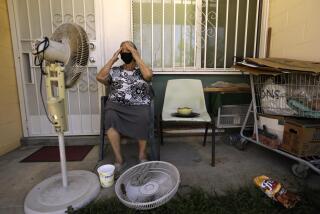THE SENSIBLE HOME : Solar-Powered Fan Keeps It Cool
- Share via
QUESTION: Our electric bills are outrageous, and the air conditioner does not sufficiently cool all the rooms. What can I do to reduce intense afternoon heat? I cannot afford to hire a contractor.
ANSWER: The simplest way to reduce intense heat is to install an attic vent fan. Adequate ventilation can lower the attic temperature by 50 degrees in the afternoon. Reducing the attic temperature throughout the day allows second-floor bedrooms to cool more quickly in the evening.
Solar-powered attic vent fans are very effective, and their operation is free. They are easy to install and require no wiring.
Thy typical solar-powered fan uses a small solar cell panel that produces 12 volts of electricity when the sun shines on it. This is ideal for attics, because the fan runs fastest and vents the most air when the sun and your attic are hottest.
There are two basic vent fan designs. The integral design has a solar cell panel on top of the fan. The remote design has a separate small panel that is wired to the fan. Because it produces only 12 volts, wiring is simple and can be exposed.
The integral design is often installed in the roof near the peak, where it can exhaust the hottest air from the attic. Integral models are most effective on roofs that face somewhat south and are not shaded.
If your roof is partly shaded or does not face south, install a remote fan kit. For the greatest air flow, mount the solar panel (only 15 inches square) in a sunny spot facing south. The mounting bracket is often included.
Install the fan in the gable so the shingles are not disturbed. It should take about 30 minutes. For two fans, one on each end of the attic, buy a larger high-output panel.
To keep the solar fan running into the evening to super cool the attic, attach the wires to a standard 12-volt battery. The battery will recharge in the daytime. Do-it-yourself battery power kits are available.
It is important to select a fan with the proper air flow capacity for your house. Solar-powered fans range from 500 to 1,000 cubic feet per minute of air flow. Electric (110-volt) models range from 800 to 2,000 cubic feet per minute.
If the fan is too small, it will not adequately cool your house. Installing one that is too large costs more to buy initially and, unless it is solar-powered, wastes electricity.
Write for Update Bulletin No. 801, which has buyer guides to 15 solar-powered and standard 110-volt attic vent fan manufacturers. The guides list air flow capacities, sizes, prices, features and a sizing chart. Please include $2 and business-size self-addressed, stamped envelope to James Dulley, Los Angeles Times, 6906 Royalgreen Drive, Cincinnati, Ohio 45244.
All Lumber Should Be Sealed, Protected
Q: I added a greenhouse to my living room for passive solar heating in the winter. I used pressure-treated lumber for most of the exterior. Is it necessary to use a preservative on the wood annually?
A: The primary purpose of using pressure-treated wood is to resist rot; it still suffers damage from sun, wind and moisture. Greenhouses are particularly hard on lumber because they typically are humid and are exposed to the sun.
All the lumber should be treated with a wood sealer and protector, like Thompson’s, every two years. Wait a month after building with treated lumber to make sure all the moisture from the treating process has dissipated.


